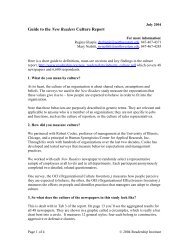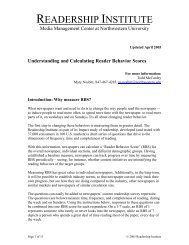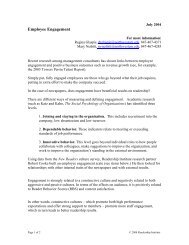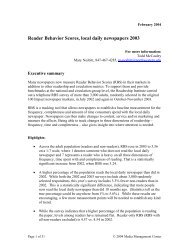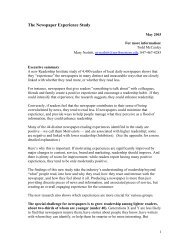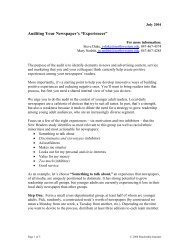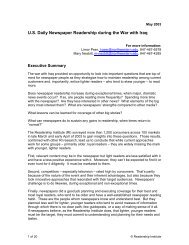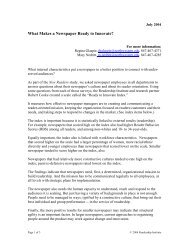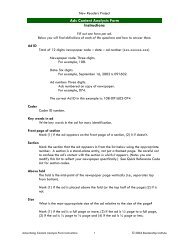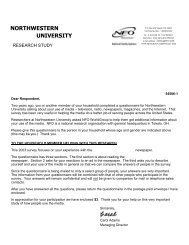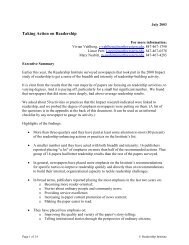Reaching New Readers: Revolution not Evolution - Readership ...
Reaching New Readers: Revolution not Evolution - Readership ...
Reaching New Readers: Revolution not Evolution - Readership ...
Create successful ePaper yourself
Turn your PDF publications into a flip-book with our unique Google optimized e-Paper software.
July 2004<br />
<strong>Reaching</strong> <strong>New</strong> <strong>Readers</strong>: <strong>Revolution</strong>, <strong>not</strong> <strong>Evolution</strong><br />
For more information:<br />
Mary Nesbitt, m-nesbitt@northwestern.edu, 847-467-4285<br />
John Lavine, j-lavine@northwestern.edu, 847-491-4900<br />
<strong>New</strong>spapers that want to forge strong bonds with younger and more diverse readers must<br />
prepare themselves for <strong>not</strong>hing short of revolution.<br />
The <strong>Readers</strong>hip Institute makes that bold assertion after five years of readership research<br />
with more than 150 large and small U.S. daily newspapers, 48,000 consumers and 12,000<br />
newspaper employees.<br />
<strong>Revolution</strong>? Won’t a minor skirmish do?<br />
No, <strong>not</strong> in the long-term. The simple truth is that newspapers can spend too much time<br />
making improvements around the edges that only benefit older, more loyal readers. In the<br />
meantime you skirt the heart of the issue – coming to grips with what makes lighter,<br />
younger readers really engage (or disengage) with your paper.<br />
That something is “experience” or “brand experience” – the thoughts and feelings<br />
consumers have about your newspaper and its relevance to their lives.<br />
Lest you think experience is touchy-feely stuff that should be delegated ASAP to the<br />
marketing department and its promotion campaigns, we hasten to emphasize that<br />
experience is firmly rooted in the news and advertising you put in the newspaper and in<br />
your service, marketing and promotion.<br />
But acting on experience goes beyond making readers more satisfied with this kind of<br />
content or that aspect of service. It’s about purposefully playing to feelings and values<br />
that readers really care about and that your newspaper could really deliver.<br />
Just think of the lifelong attachment you could build with younger readers if they came<br />
away from your news, advertising and marketing messages feeling smarter. Or equipped<br />
with something they just had to talk about with their friends. Or impressed with how the<br />
newspaper had looked out for their interests.<br />
That’s experience, and you can do a lot to make it happen.<br />
Our <strong>New</strong> <strong>Readers</strong> research identifies eight key experiences that matter to young and<br />
diverse readers. But at the moment, newspapers are doing a pretty ho-hum job in<br />
delivering them. This is a big opportunity, if you’re prepared to act boldly. Moreover<br />
each experience is relevant to core readers as well, so the benefits are widespread.<br />
Page 1 of 14<br />
© 2004 <strong>Readers</strong>hip Institute
The concepts are <strong>not</strong> revolutionary, but doing something about them is. There is no howto<br />
guide. It’s <strong>not</strong> as simple as “more of x and less of y.”<br />
Acting on an experience means thinking first of the effect you want to create in your<br />
readers, and then making content, service and marketing decisions that create and support<br />
it.<br />
Inevitably, long-held assumptions and traditions will be challenged.<br />
• Editors must make different news choices and invent different approaches and<br />
presentations based on the experiential effects that they want to create in at-risk<br />
readers.<br />
• Advertising directors must get more ads of certain sorts and execute them in ways<br />
that work for younger and/or diverse readers.<br />
• Circulators and marketers must discover how to sell to powerful reader<br />
experiences that the newspaper embodies.<br />
As we say, revolution.<br />
We are emboldened to make this call to action because of the <strong>New</strong> <strong>Readers</strong> study,<br />
conducted in late 2003-early 2004. (It is called <strong>New</strong> <strong>Readers</strong> because newspapers’<br />
primary challenge is to build new generations of readers to replace older, heavier core<br />
readers.)<br />
With results from 10,800 readers of 52 newspapers (a list of participating newspapers is<br />
at http://www.readership.org/new_readers/paper_list.htm ) we looked at how different<br />
demographic groups “experience” their local daily newspapers. We looked for<br />
connections between current experiences and content of the newspapers, analyzing<br />
33,000 stories and visuals, 12,000 ads and 21,000 in-paper content promotions. We<br />
looked inside the newspaper organizations to see whether the workforce, how it’s<br />
managed and what the expectations are, play into readers’ experiences and readership.<br />
The report that follows is divided into three parts, which correspond with our major<br />
strategic recommendations:<br />
Recommendation 1: Focus on the experiences you want to create in readers and let<br />
decisions cascade from this focus.<br />
In this way you work backwards from a desired reader-experience outcome to what<br />
content you put in the paper and how it is presented, and the kind of service and<br />
marketing you deliver.<br />
This demands a significant change in mindset across the newspaper, in both long-term<br />
and day-to-day decisions. It’s easier to move straight to specific, familiar actions – such<br />
as doing more in-paper content promotion, or providing more intensely local, people-<br />
Page 2 of 14<br />
© 2004 <strong>Readers</strong>hip Institute
oriented news – than it is to re-examine and probably overhaul your decision-making<br />
criteria. But the returns are greater.<br />
Recommendation 2: Tweak less, innovate more.<br />
Ask yourself if the changes you are considering are continuous improvement or<br />
innovation. That is, do they primarily polish various aspects of content, service and<br />
marketing? Will you do essentially what you do now but to a higher standard? Or are<br />
they bold changes or big ideas that will fundamentally change, for the better, the<br />
experiences that target groups have with the newspaper?<br />
To stimulate your thinking, we’ve laid out some of our ideas about what a newspaper<br />
could do if it were to innovate around a particular experience. That scenario starts on p. 9.<br />
Recommendation 3: Build an organization that is expected to innovate, that<br />
measures what it does and rewards progress.<br />
The evidence is very clear that whom you have in your organization, and the environment<br />
or culture that you create, are key to your ability to respond to consumers.<br />
Page 3 of 14<br />
© 2004 <strong>Readers</strong>hip Institute
Part I: Getting into readers’ heads<br />
The <strong>Readers</strong>hip Institute’s Impact (2000) study identified four cornerstones or basic<br />
building blocks for readership – content, service, brand perception and culture.<br />
<strong>New</strong> <strong>Readers</strong> goes a crucial step further. It identifies and describes the kind of reader<br />
experiences, or brand experiences, that the building blocks can be used to create. The<br />
research is in the context of younger adult readers, who read newspapers less than their<br />
elders; are unlikely to read more as they age without significant change on the part of<br />
newspapers; and are more racially/ethnically diverse than older generations. (The study<br />
builds on a preliminary exploration of the <strong>not</strong>ion of “experience” by the Institute in<br />
winter 2003; http://www.readership.org/consumers/<strong>New</strong>sExp.htm )<br />
Experiences are thoughts and feelings consumers have about your newspaper and its<br />
relevance to their lives.<br />
Some experiences come from things over which the newspaper has no control – for<br />
instance a person’s background that instilled a love of reading or a passion for current<br />
events. (Not surprisingly, the most powerful experience readers have with a newspaper is<br />
“enjoy reading.”)<br />
But with many others, newspapers have great opportunities to intervene and enhance<br />
readers’ feelings and reactions. If you can substantially drive experiences that motivate<br />
readers’ usage, you can grow readership.<br />
High-reading and low-reading experiences<br />
The <strong>New</strong> <strong>Readers</strong> study identifies 34 distinct experiences. Of those, 22 are positively<br />
related to readership – the more people have them, the higher their readership – and are<br />
called Motivators. The rest are negatively linked – the more people have them, the lower<br />
their readership – and are called Inhibitors. A full list is at<br />
http://www.readership.org/new_readers/data/all_experiences.pdf<br />
Building the Motivators and reducing the Inhibitors will strengthen readership.<br />
Here’s a key point: there is plenty of room to move. Overall, readers have a fairly tepid<br />
experience with their local daily newspaper. Moreover, our content analysis shows that<br />
newspapers take a pretty similar approach to what they publish and how it is presented.<br />
Together, these findings tell us that newspapers must take bold, <strong>not</strong>iceable, strongly<br />
marketed steps to significantly change those experiences and build reader engagement.<br />
Thirty-four experiences are too many to contemplate, let alone tackle, at once. We pared<br />
the list to eight key experiences that hold promise for readers in general and for younger<br />
adults, African-Americans, Hispanics/Latinos and Asians/Pacific Islanders in particular.<br />
Page 4 of 14<br />
© 2004 <strong>Readers</strong>hip Institute
There are many synergies among the eight experiences: Intensify one and it can have<br />
beneficial effects on others.<br />
More detail on the eight key experiences is at<br />
http://www.readership.org/new_readers/data/key_experiences.pdf. We strongly<br />
recommend you spend time getting familiar with all the consumer-based feelings<br />
expressed.<br />
The chart below summarizes the key points.<br />
Page 5 of 14<br />
© 2004 <strong>Readers</strong>hip Institute
Experience What it means Examples of consumer<br />
statements<br />
Something to talk<br />
about (Motivator)<br />
Makes me smarter<br />
(Motivator)<br />
People use the newspaper<br />
as a socializing device –<br />
telling others about what<br />
they’ve read, discussing<br />
news with friends and<br />
family, acting as<br />
information brokers.<br />
The newspaper helps<br />
people get more out of<br />
life and learn new things.<br />
“I bring up things I’ve read<br />
in this newspaper in<br />
conversations with other<br />
people.”<br />
“I like to give advice and<br />
tips to people I know based<br />
on things I’ve read in this<br />
newspaper.”<br />
“Even if I disagree with<br />
things in this newspaper, I<br />
feel like I have learned<br />
something valuable.”<br />
“It is a way to learn about<br />
new products.”<br />
“I learn about things to do<br />
or places to go.”<br />
Our observations<br />
Make it the focus of<br />
innovation. Not only is it a<br />
powerful driver for<br />
readership, but you have<br />
the resources to leave other<br />
media in the dust.<br />
Young, white adults are<br />
experiencing it the least of<br />
all groups.<br />
Build it and you’ll enhance<br />
“something to talk about,”<br />
too.<br />
An especially strong<br />
readership driver for<br />
African-American women.<br />
Younger, less-educated<br />
readers are least likely to<br />
feel the newspaper makes<br />
them smarter.<br />
Looks out for my<br />
civic and personal<br />
interests<br />
(Motivator)<br />
Discriminates and<br />
stereotypes<br />
(Inhibitor)<br />
Ad Usefulness<br />
(Motivator)<br />
The newspaper helps<br />
people take part in the<br />
community and also acts<br />
as a watchdog for the<br />
community.<br />
The newspaper’s interest<br />
in minorities is mostly<br />
commercial, and it<br />
perpetuates stereotypes.<br />
The newspaper is a<br />
marketplace for goods<br />
and services, and acts as a<br />
guide for what’s out<br />
there.<br />
“It gives me ideas about<br />
how to help in the<br />
community.”<br />
“I count on this newspaper<br />
to investigate wrongdoing.”<br />
“Reading this newspaper<br />
makes me feel like a better<br />
citizen.”<br />
“This paper has a history of<br />
discrimination against<br />
minorities.”<br />
“They only target<br />
minorities for their money.”<br />
“I like the ads for unusual<br />
things.”<br />
“It makes me want to go<br />
shopping.”<br />
<strong>Readers</strong> value what a<br />
journalism-based business<br />
values: being citizens as<br />
well as consumers. Perfect!<br />
Now, really deliver on it.<br />
Young people are less<br />
likely to have this<br />
experience with newspapers<br />
than their elders; white<br />
people more likely than<br />
non-white.<br />
African-Americans feel this<br />
most of all, followed by<br />
Asians/Pacific Islanders<br />
and Hispanics/Latinos. It<br />
inhibits readership most<br />
strongly among 18-24 year<br />
olds.<br />
Younger adults more likely<br />
to feel this way than their<br />
elders.<br />
Page 6 of 14<br />
© 2004 <strong>Readers</strong>hip Institute
Value for my<br />
money<br />
(Motivator)<br />
Whether through direct<br />
savings or other forms of<br />
enrichment, the<br />
newspaper is worth the<br />
price.<br />
“I save more money from<br />
its ads and coupons than I<br />
spend on the paper.”<br />
“Even if this newspaper<br />
cost twice as much as it<br />
does now, I would still read<br />
it.”<br />
Hispanics/Latinos and<br />
African-Americans feel this<br />
more than white people.<br />
“Value for my money” is a<br />
strong driver for 18-24 year<br />
olds.<br />
Good service<br />
(Motivator)<br />
The newspaper is reliably<br />
available and in good<br />
shape.<br />
“I always get it when I want<br />
it.”<br />
“I always get the<br />
newspaper in good<br />
condition.”<br />
While all groups have a<br />
positive experience with<br />
service overall (it has the<br />
highest rating of eight key<br />
experiences), it still has<br />
strong potential to drive<br />
more readership.<br />
Too much<br />
(Inhibitor)<br />
People feel the newspaper<br />
is daunting – too much in<br />
it and stories are too long.<br />
“I wish the newspaper had<br />
fewer pages.”<br />
“Too many of the stories<br />
are too long.”<br />
Young people, especially<br />
18-24 year olds, are more<br />
likely to have this reaction<br />
than other groups.<br />
In summary, experiences are powerful, consumer-based realities that our research has<br />
identified, quantified and validated. They apply to magazine-reading as well, with many<br />
similarities and some important differences. (See<br />
http://www.medill.northwestern.edu/faculty/malthouse/ftp/magexp.html )<br />
And there are many other reasons to pay attention:<br />
• Experiences are highly predictive of readership – more predictive than satisfaction<br />
with content, for instance.<br />
• Preliminary research shows that newspapers that deliver stronger motivating<br />
experiences also give a boost to the impact of the ads in their pages. (See<br />
http://www.medill.northwestern.edu/faculty/malthouse/ftp/geneva.html )<br />
• Acting on experiences requires a deep understanding of how consumers feel that<br />
can’t be gleaned from data in a questionnaire. It will force you to talk, frequently,<br />
with at-risk customers – the ones you need to develop to ensure future readership<br />
– and act on what you hear. It will help your newspaper become more readerfocused.<br />
• Consumer experiences reveal many intersections between what consumers value<br />
and what a journalism-based enterprise values. There are also many disconnects.<br />
• Focusing on the effect you want to create in consumers will make you re-evaluate<br />
everything you do. It will change the way you make and sell the newspaper.<br />
For suggestions on how to do an internal audit on the experiences your newspaper<br />
currently delivers, and how to assess whether changes are working, see:<br />
http://www.readership.org/new_readers/data/auditing_experiences.pdf<br />
http://www.readership.org/new_readers/data/measuring_results.pdf<br />
Page 7 of 14<br />
© 2004 <strong>Readers</strong>hip Institute
Part 2: Improve vs. Innovate<br />
If experiences are such a powerful force for readership, how can you intensify them?<br />
There are two options. One is to take cues from what is currently creating experiences –<br />
for instance, certain kinds of content and techniques for presenting them – and to do more<br />
of the same.<br />
The other is to innovate. Innovation is about creating and implementing big ideas,<br />
currently <strong>not</strong> in play, that will substantially change the experience for the better for<br />
groups the newspaper wants to reach.<br />
Here’s an example of the difference. Doing more in-paper content promotion – such as<br />
skyboxes or rails – on the front page is an improvement. Turning the front and back<br />
pages into a combined physical and content “wrap” – a digest of all the news in today’s<br />
paper – is an innovation. The first action is a navigational tool that helps readers choose<br />
what they read. The second is both a guiding device and a new experience – a quick but<br />
thorough tour of today’s news. Both combat the “too much” experience, but in very<br />
different ways.<br />
We glean insights into improvement by looking at the eight key experiences and the<br />
elements of content and service that currently drive them. That detail is provided in<br />
http://www.readership.org/new_readers/data/content_service_drivers.pdf<br />
For instance, it is clear that for younger adults a mix of content – in particular hard news,<br />
feature and lifestyle news, movies and music, and ads about places to go and things to do<br />
– currently helps create the experiences “something to talk about,” “makes me smarter”<br />
and “looks out for my personal and civic interests.”<br />
In terms of approaches to that content, dynamic visuals (such as number of photos, who’s<br />
in them, action photos) have a strong effect on experiences. And within those broad<br />
content categories, specific topics – such as environment news, health news and<br />
recreation advertising – have untapped potential.<br />
But we must reiterate that improving what newspapers do now will bring only limited<br />
success, because it focuses only on the current range of possibilities. In other words,<br />
don’t do essentially the same things and expect to get substantially different results.<br />
Remember that readers generally have tepid experiences with newspapers. Moreover,<br />
content analysis shows that newspapers, regardless of market, tend to take similar<br />
approaches to defining and presenting news and advertising content. (See results of the<br />
content analysis at http://www.readership.org/new_readers/data/content_analysis.pdf )<br />
From this we infer the greatest opportunity for newspapers lies in innovation.<br />
Page 8 of 14<br />
© 2004 <strong>Readers</strong>hip Institute
A picture of an experience-driven newspaper<br />
There is no template to follow. To stimulate your thinking we’ll lay out some of our ideas<br />
about how your newspaper could innovate around an experience. For simplicity’s sake,<br />
we’ll focus mostly on the mainsheet with its current sectional structure.<br />
First, we establish simple central ideas that will guide our tactics. The consumer<br />
experience that animates our newspaper is “something to talk about.”<br />
• We’ve listened to readers describe their lives, how they use news and how<br />
they use our newspaper, and realize that for many people, of all ages, news is<br />
a socializing tool. They use it to connect with others. So our newspaper will<br />
provide a high proportion of content that people can’t get anywhere else, with<br />
a strong quotient of “did you see that [story/photo/column/ad] in the<br />
Hometown Gazette today?”<br />
Our internal values also shape what we do.<br />
• We value straight (but civil) talk, debunking myths, simplifying the<br />
unnecessarily complicated, respecting our readers’ time and making our<br />
community a better place to live.<br />
These two principles are reflected in everything from the way we write stories and<br />
headlines, to our relationships with customers, to the causes the newspaper embraces.<br />
Next, how will we make news content more of a “something to talk about” experience?<br />
From the vast array of locally assigned and news service material available, editors will<br />
make at least 50 percent of their news choices (both stories and visual elements) on a<br />
single criterion: Will they produce a strong “did you see this story/photo in the<br />
newspaper?” reaction among our target readers.<br />
If any story does <strong>not</strong> have a strong and clear “why you should care” element, it does <strong>not</strong><br />
run. Wherever possible, we also include “what you can do about it” information.<br />
Starting at the assignment stage, we approach most government or institutional stories<br />
and visuals with a focus on what the event, action or policy means to readers, rather than<br />
what happened.<br />
We shoot and choose photos that are rich in meaning and show people and activity.<br />
They’re <strong>not</strong> decoration – they tell stories that are worth telling. We make liberal use of<br />
standalones, with ample, informative cutlines.<br />
All significant stories carry a prominent box asking readers what else they want to know<br />
or see about the story. They can tell us by phone, e-mail or snail-mail. Every day we use<br />
this input to help shape follow-up stories and visuals. But we’re <strong>not</strong> just reactive – we<br />
maintain an online panel of readers in our target groups, and ask them daily what we<br />
Page 9 of 14<br />
© 2004 <strong>Readers</strong>hip Institute
should be doing on key news stories and issues. (Are they dictating content? No, they’re<br />
sharpening our news instincts and our news report. They’re providing intelligence from<br />
the field.)<br />
Most of the time we handle “commodity news” – news readily available in other media<br />
or likely to be dated by the time it appears – in briefs packages. We reserve full<br />
story/package treatment for news that is unique, or where we can put a compelling,<br />
differentiated angle or perspective on important news that happened yesterday.<br />
We realize only a small percentage of our readers follow news developments in ongoing<br />
stories as doggedly as we do, so we handle them in an “update” fashion. That is, we<br />
either brief them in a column or package, or if we are giving full story treatment, we<br />
dress them with an update background box. Both formats are backward- and forwardlooking,<br />
telling readers succinctly what’s happened and what’s likely to happen next.<br />
We give major stories and personalities follow-up treatment after they have fallen from<br />
the active news agenda. In fact, we require reporters, photographers and editors to keep<br />
track of stories they’ve covered or handled that will make good candidates for follow-up<br />
some time down the road. We solicit “whatever happened to” ideas from readers and we<br />
encourage (with prizes and recognition) employees from all departments to contribute<br />
ideas.<br />
Every day, in every section, we take at least one story or issue and present it in a<br />
“debatable” format. We lay out different sides of a controversy, simply and clearly,<br />
without taking sides. We ask readers what they think, and tie this to a news discussion<br />
Web site that we’ve started (see below).<br />
We often hear readers say how they lack the background to follow complicated stories.<br />
So several times a week we select one of those and explain its essentials – briefly and as<br />
simply as possible – with words and/or graphics. The challenge is to simplify without<br />
over-simplifying or misrepresenting. We use this technique in all sections, using our best<br />
writers and thinkers to show how it’s done.<br />
We regularly highlight “quick fixes” or physical improvements that will make the<br />
community a more pleasant and safer place to live. You might dismiss this as a cosmetic<br />
approach. But we want to balance the in-depth reporting we do on complex social,<br />
economic and infrastructure ills with things people can see, feel and touch immediately.<br />
Our front page is never a reprise of yesterday’s TV or radio news. To the extent that we<br />
have any of those reports, they are updates or different angles. At least 75 percent of<br />
stories and visuals are unique to the newspaper. At least one story is intrinsically a<br />
“talker.”<br />
At least half of our headlines are engaging, pointed, punchy or sell the story, rather than<br />
simply descriptive. We rarely use label heads.<br />
Page 10 of 14<br />
© 2004 <strong>Readers</strong>hip Institute
We’ve re-thought some beats to discover different kinds of news. At least two are<br />
centered on populations (such as under-35s) rather than institutions or topics. We staff<br />
them with visual and word people whose mission is to find content about the lives, issues<br />
and matters of importance to these groups. They’re also on the lookout for people who<br />
would be strong contributors to the newspaper and our discussion Web site.<br />
We established a “talk about it” beat, based on what readers (especially in the target<br />
groups) are talking about and what they want to know. Sounds corny, right? But the best<br />
way to get good new material is to put creative, savvy, open-minded journalists on the<br />
case. <strong>Readers</strong> generate story ideas and ask burning questions and whenever possible we<br />
credit them with the ideas. Internally, we encourage all newspaper departments to<br />
contribute.<br />
We’ve developed two strong local daily news columnists, and one each in lifestyles,<br />
entertainment and sports. They have a challenging mandate: to discover news about<br />
things that matter to our target audiences before they comment, and to write in a way that<br />
gives readers “something to talk about.” They also participate in the newspaper<br />
discussion Web site, below.<br />
We’re working on developing an easy way for readers to e-mail information – stories,<br />
photos, graphics, coupons, ads – to a friend or family member without having to search<br />
through the Web site.<br />
On to Advertising. We showcase members of the targeted audience in the ads we create<br />
or can exert influence on – local people who are shopping for the product in our<br />
advertisers’ stores or who comment on the product/service.<br />
Wherever possible, we provide “go-and-do” stimulus with times, locations,<br />
demonstrations, product comparisons and so forth. We’re aware that readers, especially<br />
younger adults, are turned off by information clutter and like to do research and<br />
comparison shopping online, so ads also refer readers to Web-based information.<br />
We feel we’ve ceded some turf to television and magazines, so we focus on creating ads<br />
that <strong>not</strong> only push “buy” elements such as price or promotion, but have a strong “why”<br />
effect. We challenge our advertising creators to make content that is so clever and<br />
arresting that it will generate buzz among target readers as well as results for advertisers.<br />
And we use in-paper content promotion to point to this advertising.<br />
We’ve begun a “real deals” feature that highlights value on selected products or services<br />
that our newspaper advertisers are offering and that are of interest to our reader target<br />
groups.<br />
In Service we’ve introduced loyalty pricing, so that now our most loyal customers get the<br />
best subscription offers. We’ve stopped ramping-up practices that just encouraged people<br />
to churn. This was a very scary step, but the significant changes in content made the<br />
Page 11 of 14<br />
© 2004 <strong>Readers</strong>hip Institute
value much more apparent and attractive to new readers. And we’ve been able to<br />
ballyhoo this real revolution in pricing in our marketing campaigns.<br />
When we promote other aspects of customer service, we make a point of highlighting<br />
customers – ordinary people – who have been surprised and delighted by the treatment<br />
they received.<br />
Every three or four months, we gather our most talkable or talked-about stories and<br />
visuals into a special section. It’s a bonus for current readers and we use it as a marketing<br />
piece for prospective customers.<br />
We haven’t forgotten affiliated media. We’ve developed what we call a populist Web<br />
log that is seeded and moderated by “experts” (us), but most of the conversation is among<br />
readers. It’s a combination of selected news posts with commentary, and interactive<br />
features. The target is 18-34-year-olds who like to discuss current events. (We think a key<br />
to our future is showing news can be fun and engaging and interactive.)<br />
Among the interactive features we’ve included:<br />
• <strong>Readers</strong> forecast outcomes to current issues or events.<br />
• <strong>Readers</strong> predict ideas and products that will become mainstream.<br />
• <strong>Readers</strong> put themselves in the shoes of political, judicial, business, sports or<br />
cultural decision-makers who currently face a tough issue. What would they<br />
decide and why?<br />
• <strong>Readers</strong> untwist the spin of the day/week.<br />
The best of this Web log runs daily in the print newspaper. You can read more about the<br />
blog idea at http://www.readership.org/new_readers/data/website_innovation.pdf<br />
Now You Take the Plunge<br />
We’re certain you’ll have little trouble coming up with innovative ideas to build<br />
experiences – and readership – among the groups you want to reach. Moreover, they will<br />
be far more inventive and far-reaching than the examples we’ve given.<br />
But be prepared to implement many of them, <strong>not</strong> just one or two, if you want them to be<br />
<strong>not</strong>iced by readers and to change their experiences.<br />
Don’t bury them.<br />
And market them.<br />
Page 12 of 14<br />
© 2004 <strong>Readers</strong>hip Institute
Part 3: An organization ready, willing, able – and expected – to innovate<br />
The third campaign in the experience revolution has to be waged inside.<br />
<strong>New</strong>spapers that want to act boldly and effectively on consumer experiences need to<br />
build an organization that:<br />
• Has a strategic focus on readership. Without a readership strategy, with specific<br />
goals and targets, newspaper employees won’t have a context to guide their<br />
activities.<br />
• Expects continuous innovation in the service of readership. If innovation isn’t<br />
made part of the stated expectations for departments and individuals, newspapers<br />
will do essentially the same things and get substantially the same results.<br />
• Rewards readership growth. If the reward and recognition system doesn’t focus<br />
on readership, employees will logically conclude it’s really <strong>not</strong> a priority.<br />
Reader/customer focus, expectations and rewards are all part of a newspaper<br />
organization’s culture, or “the way we do things around here.”<br />
They and many other culture components were analyzed in the <strong>New</strong> <strong>Readers</strong> study, using<br />
input from 6,600 employees at all levels and every department of the newspaper. The<br />
data were also analyzed by gender, age, race/ethnicity, length of tenure with the<br />
organization and position in the newspaper. For more details, see<br />
http://www.readership.org/new_readers/data/how_to_read_culture_report.pdf and<br />
http://www.readership.org/new_readers/data/industry_culture.pdf<br />
In addition, we collected workforce data from each newspaper<br />
(http://www.readership.org/new_readers/data/workforce_census.pdf ) and constructed a<br />
measure of employee engagement<br />
(http://www.readership.org/new_readers/data/employee_engagement.pdf )<br />
The results are very clear. <strong>New</strong>spapers that get better readership results now and are<br />
better positioned to make change for the future tend to have constructive, adaptive<br />
cultures. They have better management practices. They tend to have greater diversity in<br />
race and/or gender, both in the workforce generally and in positions of influence.<br />
All but five of the 48 newspapers that completed the internal culture surveys are<br />
characterized by defensive cultures, where risk-taking is <strong>not</strong> encouraged and crossdepartmental<br />
collaboration is infrequent. (And although the Impact 2000 and <strong>New</strong><br />
<strong>Readers</strong> studies are <strong>not</strong> directly comparable because of the different methods used in<br />
selecting markets, we <strong>not</strong>e the results are consistent.)<br />
Constructive cultures, by contrast, are more customer-focused, adapt more quickly to<br />
changes in the market and are able to collaborate across departments.<br />
Page 13 of 14<br />
© 2004 <strong>Readers</strong>hip Institute
Their employees are more engaged – that is, they’re <strong>not</strong> only present for work and<br />
performing to standard, but often perform above standard and are deeply involved in<br />
crafting the newspaper’s future. Throughout this report we’ve stressed the big<br />
opportunities for newspapers to enhance readers’ experiences; the opportunities are just<br />
as great inside the newspaper to intensify their employees’ experience, or their<br />
engagement.<br />
A constructive culture is neither an ironclad guarantee nor a necessary pre-condition for<br />
higher readership. But both Impact and <strong>New</strong> <strong>Readers</strong> showed a strong relationship<br />
between newspapers that had weaker defensive behaviors and stronger constructive<br />
behaviors and general readership. And in <strong>New</strong> <strong>Readers</strong>, readership among under-served<br />
groups was higher, and some of the key experiences were also more strongly felt.<br />
Further, we suggest that if a newspaper is change-resistant and <strong>not</strong> tuned in to customers,<br />
bold and timely innovation is unlikely – at least within the core organization. But if<br />
employees at all levels are expected to be reader/customer-focused and if risk-taking is<br />
rewarded, conditions are more hospitable to innovation.<br />
We tested this <strong>not</strong>ion by developing a “readiness to innovate scale” from the <strong>New</strong><br />
<strong>Readers</strong> organizational data. (For details, see<br />
http://www.readership.org/new_readers/data/readiness_to_innovate.pdf )<br />
The highest-scoring papers have these things in common:<br />
• They are more constructive and less defensive than the rest.<br />
• They are more attuned to the marketplace.<br />
• They are quicker to react to changes in the market and in customers.<br />
• Their employees are much more “engaged” with the newspaper.<br />
• They are better at articulating the mission and involving employees in<br />
decisions that affect them and the business.<br />
• They provide more training and development.<br />
• They have a higher proportion of female and non-white employees.<br />
• They have a higher proportion of female and non-white employees in<br />
positions of influence.<br />
But even “the best” have much room for improvement – there are no models from this<br />
study that we recommend others should emulate. But the direction is clear: change the<br />
culture <strong>not</strong> just because it’s the nice or right thing to do, but because it will also enable<br />
you to win new readers.<br />
If you have any questions or comments about this report and its recommendations, or<br />
about other <strong>New</strong> <strong>Readers</strong> reports, don’t hesitate to contact us at institute@readership.org<br />
For a full list of downloadable <strong>New</strong> <strong>Readers</strong> reports, go to:<br />
http://www.readership.org/new_readers/all_reports.asp<br />
Page 14 of 14<br />
© 2004 <strong>Readers</strong>hip Institute



